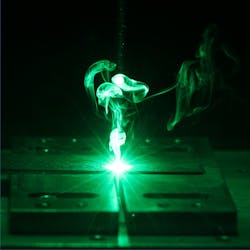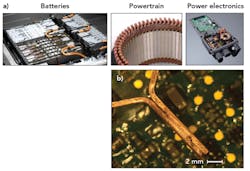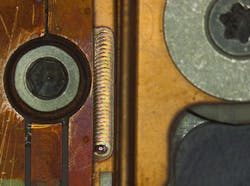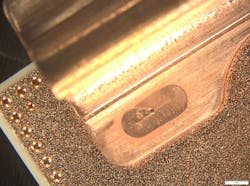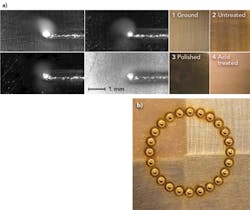Laser welding at the green wavelength benefits electrified mobility applications
HENRIKKI PANTSAR, EVA-MARIA DOLD, MARC KIRCHHOFF, and OLIVER BOCKSROCKER
e-Mobility has become the most important development trend in the automotive industry worldwide during the past five years. Demand for electrified vehicles is increasing substantially because of high performance, driving comfort, ease of operation, reduced maintenance requirements, and environmental factors. Legislation is also driving electrification of transportation1 and electrified cars are not a niche in the automotive market anymore.
One of the tasks for OEMs, suppliers, and machine builders in the automotive industry is to create reliable technologies from supply chains, and ramp up production of electronic components. This includes handling all aspects of production related to the electrified powertrain. One of the greatest challenges is that components and materials in the electrified powertrain are completely new or used in a different way than what is custom to the automotive industry. For example, production volumes required of high-capacity batteries or suitable electric motors are unprecedented not only in the automotive industry, but any industry in general.
Crucial components
The most important component is the battery, which consists of single battery cells assembled to battery modules that are then assembled to a battery pack. Reliable battery management systems are needed, as well as housings for the cells and modules for integrating the batteries in the vehicle. Various other electrical components, such as charging systems, converters, and sensor systems, are required to charge the batteries and manage electrical power inside the car.
Besides the battery, an electric drive is needed to bring the power on the road. There are many different designs for the electric drives, from a hybrid drive (a drive concept where the electric drive is directly integrated into the gearbox) to a four-wheel drive, where four electric drives are mounted near the wheels.
What these components have in common is that they did not exist before in a car and, consequently, there is no substantial accumulated experience with these parts. One of the main materials in these components is copper.
Production of all these parts includes lots of challenges with a vast number of opportunities, as manufacturing processes are being defined without a prior gold standard. There is a lot of room for innovation—the laser, as a very flexible tool, can be the key for the eMobility. With this tool, it is possible to fulfill the new requirements in terms of productivity and quality, and scale up production from current small production volumes to high volumes needed in the near future.
Possibilities with lasers
The number of possible laser applications and volume of produced components increases with the eMobility market. Especially in the area of power electronics, powertrain, and battery manufacturing, the laser enables fast welding and cutting with minimal heat input. However, the requirements in each of these areas differ significantly. Welding of electronic contacts on direct bonded copper (DBC) plates requires an exact welding depth, minimal spatter, and heat input, as the surrounding components are very close to the welding position and would be destroyed if the process lacks stability. In the e-powertrain, the welding of hairpins requires high laser power and welding speed with minimal pores and spatters to generate good electrical properties. The same requirements are preconditioned in battery contacts, where accurate welding performance is a key factor for high quality and productivity. Again, most laser applications in these areas of eMobility components contain parts made of copper—the preferred domain for green-wavelength lasers (FIGURE 1).The biggest advantage of copper, its high electrical and thermal conductivity, is also the biggest challenge for welding. Ten times higher heat conduction than in commonly used steels requires a very intense energy input. This could be solved with lasers, as this technology contributes high energy intensity on small interaction zones. However, similar material properties, which lead to high electrical conductivity, also lead to high reflectivity. Lasers deliver energy onto the workpiece in the form of light, typically in the near-infrared (near-IR) spectrum. Reflective metals and most transparent materials typically absorb only a small fraction of IR laser light, which creates a challenge for IR lasers.
Only about 5% of the laser energy could be used for heating up the material in copper welding.2 High intensity is needed to initiate the welding process and heat the material from room temperature, where absorption of the laser light is low. The room-temperature copper surface reflects almost all the laser power to the surroundings, including optics. While this is very inefficient in terms of energy transfer, this could also damage sensitive parts. The absorption of the IR laser beam increases with the temperature up to more than 15% at melting temperature, but this transition is hard to control.3 The process needs a high intensity to start, but with increasing absorption, the material could overheat. Therefore, heat conduction welding is not well-reproducible. Deep penetration welding, on the other hand, suffers, especially at a low feed rate from weld defects —for example, melt ejections.4 And, because of lower surface tension and viscosity of copper compared to steel, the melt pool is less stable.
Green laser capabilities, benefits
Absorption of the green laser (515 nm) to copper is 35–40%, so the welding process can be very stable without problems with initial absorption and overheating. Parameters are easy to find and process strategies such as wobbling are not needed. The green lasers by Trumpf are based on thin disk-laser technology and systems are ready for industrial use. The laser light is fiber-guided for easy integration into the machine.
It is possible to reproducibly weld even foils and small copper parts up to 0.4 mm in thickness in the heat conduction welding mode due to the good absorption of the green laser beam to copper. In the absence of the keyhole and resulting melt dynamics, completely spatter-free copper welding with green lasers has been demonstrated (FIGURE 2). This was testified by high-speed video films in which one could see a perfectly smooth melt surface without motion. With comparable IR lasers, reproducible heat conduction welding with copper is not possible because the absorption is temperature-dependent, and the process easily shifts from heat conduction welding to deep penetration welding. Depending on the welding mode, copper foils are either not connected or destroyed.Keeping the process temperature constantly between melting and evaporation temperature is not possible with IR laser beam welding. Because of process stability and high absorption, high feed rates are possible with the green wavelength, which reduces heat loss from thermal conduction and thermal expansion. Heat conduction welding with green lasers is the first choice for battery foil welding and connecting small copper parts in electrical components (FIGURE 3).
For very heat-sensitive parts such as DBC plates or welding in heat-sensitive environments, it is recommended to use a microsecond-pulsed green laser. A pulse mode offers more possibilities for thermal process management. The pulse pause effectively reduces thermal stress on the parts and the surrounding material. Gaps up to 0.1 mm are easy to handle by increasing the pulse overlap of the green laser. The material will cool down after each pulse and the thermal input can be reduced. In contrast to IR lasers, welding with a green laser beam does not present a problem with the interpulse cooling and following lack of temperature-dependent absorption.
Conclusion
Copper welding has become one of the most important research topics in the automotive industry because of eMobility. New techniques are needed to produce low-spatter, high-quality welds in copper. Using green wavelength lasers has proven to be a desired method for copper welding. Instantaneous absorption onto a copper surface, in combination with a stable process, is a great advantage when welding electrical components in batteries and electronics. Because of the lack of spatter, even pre-assembled electronic components can be welded without the risk of shorts. Industrial pulsed lasers with 400 W average power and 4 kW peak power are now available, as well as continuous-wave (CW) lasers up to 1 kW. Challenges of laser welding of copper have been overcome with this technology.
REFERENCES
1. See https://bloom.bg/2Pn2YfK.
2. J. Bliedtner, H. Müller, and A. Barz, Lasermaterialbearbeitung Grundlagen – Verfahren –Anwendungen – Beispiele, Hanser, Munich, Germany (2013).
3. S. Amorosi, T. C. Sidler, R. P. Salathe, H. P. Schwob, and J. Hertzberg, Proc. SPIE, 5063, 1, 1–7 (2003).
4. A. Heider et al., Phys. Procedia, 41, 112–118 (2013).
5. S. Engler, R. Ramsayser, and R. Proprame, Phys. Procedia, 12, 342–349 (2011).
HENRIKKI PANTSAR ([email protected]), EVA-MARIA DOLD, MARC KIRCHHOFF, and OLIVER BOCKSROCKER are all with Trumpf, Ditzingen, Germany; www.trumpf.com.
